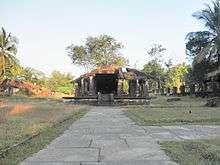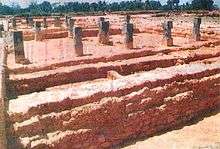Barkur
| Barkur ಬಾರ್ಕೂರು | |
|---|---|
| Town | |
 Barkur  Barkur Location in Karnataka, India | |
| Coordinates: 13°28′00″N 74°44′59″E / 13.4668°N 74.7498°ECoordinates: 13°28′00″N 74°44′59″E / 13.4668°N 74.7498°E | |
| Country |
|
| State | Karnataka |
| District | Udupi District |
| Languages | |
| • Official | KannadaTulu |
| Time zone | IST (UTC+5:30) |
Barkur is a cluster of 3 villages [Hosala, Hanehalli, Kachoor] in Udupi district of the Karnataka state in India. The place is located on the bank of river Seeta. It is also called as village of temples.
Barkur is located 16 km from Udupi, another ancient city. The Seeta river flows through Barkur and joins the Arabian sea.[1]
History
Barkur was the ancient capital of the Tulu kingdom. It was known as Barakanur.[2] The rulers were known as Tulu kings or rulers. They spoke Tulu language. Most of the districts ruled by them were in coastal Karnataka. Many ancient inscriptions found in Barkur are in Tulu language. These are an essential part of history of Tulunadu. The Coastal Town of Barkur was also a flourishing port in the 15th and 16th centuries.
Apart from the Tulu rulers, Alupa rulers made Barkur as their capital. Archaeological findings suggest that Barkur was a province under the Vijayanagar Empire in 14th century A.D. Pandarideva was the Governor of this province under the regime of Harihara II.[3] There are remains of two forts built by the Alupas and Vijayanagara governors. It was also a sub capital of the Hoysala kings for some period. The city had ten extensions called Keris - each being named after its professional residents. Each Keri had a tank and number of temples. Tradition says that, the King visited a temple every day, thus visiting all the temples of the city and on the last of the year, he visited the most important Panchalingeshwara Temple. That day was the day of car festival of this temple situated with the old Fort area called "Kotekeri". As per tradition, the city contained 365 temples, the remains of which can be seen to-day. A few of them are now in renovated condition. Besides, there are Bhutastanas (spirit worshipping centres). There are remains of palaces and other constructions in both the Fort areas. The port town was a busy commercial centre almost from 2nd Century B.C. Evidences of Megalithic and mesolithic ages have been discovered recently. The place abounds with history and has yielded a little over 100 stone and several copper plate inscriptions. They belong to the Alupa, the Hoysala, the Vijayanagara and the Keladi periods.
Today, the main language spoken in Barkur is Kannada, which is the official language of the State of Karnataka. Konkani, another local language, which is also said to be an Aryan language, is widely spoken in Barkur.
The place has several ancient temples with their typical sloping terracotta-tiled roofs. Many of these temples also contain inscriptions of historical value. Most of these temples are built between 9th and 12th centuries. As you enter Barkur the first thing you see is the Kallu chappara, which means roof of stone. A nandi is seated in this chappara. Sri Kalikamba Temple is also one of the famous temple which was built around 14th century.
Barkur is the holy place for Mogaveera community. It has an ancient temple, Kula Maha Sthree Amma Temple , which is visited by Mogaveeras from all over the world.
Temple Architecture
The temples at Barkur have a distinct architecture. The sloping terracotta-tiled roofs bear resemblance to the temples of Kerala, but they do not have gopurams, a common feature of the Dravidian style South Indian temples.
- Chowlikere Ganapathy Temple
Chowlikere Ganapathy Temple was constructed 900 years back,[2] during the Chola Period. The Bairagi Ganapathy Temple is entirely hewn out of stone with a slanted stone roof and etched stone pillars. The stone walls of this temple display beautiful sculptures and it is apparent that this mammoth structure has withstood the ravages of time.The Panchalingeshwara Temple, dedicated to Lord Shiva, is Barkur’s largest temple, and is one of the oldest in the town. Its double-storied gateway, with a pillared verandah on either sides, is most alluring. The rear side of the temple has an elephant-back-like curvilinear structure.The pillars that surround the circumambulatory path of the temple are decorated with carvings depicting mythological characters.
- Kathale Basadi

A 20-feet monolithic stone pillar is erected at the entrance.[2] The temples were elegantly designed with carvings and embellishments, but are now in ruins. The twenty-four dents in the stone are the only evidence of the existence of idols of the twenty-four Jain thirthankaras.[4] There are three main structures in a big courtyard with a victory pillar at the entrance. Archaeologists say that they were built between the 8th and 12th Century A.D. Built by the Alupa rulers, the Jain Basadi, unlike most South Indian temples built in the Dravidian style, does not have a gopuram. The sanctum sanctorum is surrounded by stone walls otherwise known as Prangan, with sloping stone pillars over it. The original Mahavira idol was destroyed but has been replaced by stone tablets with animal figures that are a later addition.[5]
Katthale Basadi consists of Navranga with Nagkaali, Shiva, Vishnu and Jain deities with separate temples. It proves the existence of changing kingdoms with various rulers trying to control the city both politically and in terms of religion.[6]
Barkur Fort
The Barkur fort is spread across 20 acres of land. Inside the fort there are ruins of the kingdom. There are pillars used to tie horses and elephants which formed the part of the army. This fort was excavated several years ago by the archaeologists in a few acres of land, which is now an excursion site.[7]
Some of the famous places
1.Temples of Panchalingeshwara, Mahalingeshwara, Batte Vinayaka, Gopalakrishna, Someshwara (Siddeshwara) of Manigara Keri, Somanatha, Banashankari, Hattara Narayana, Mahalingeshwara & Bairavaganapati (Chaulikeri) Balagara Keri Mahalakshmi etc.
2.The Island of Bennekudru. Mogaveera Kula Maha Sthree Amma Temple
3.Old Fort and palace area called Simhasanagudde.
4.Padarasabavi (well of Mercury) and ruins of Hinguladevi temple.
5.The Vijayanagara Fort and the place called Nandana Kote.
6.Well preserved katthale basadi.
7.Sri Kalikamba Temple
8. Malik Dinar Jumma Masjid
9. St- Peter Church
Must visit places
- KATTHALE BASADI
- EXCAVATION AT VIYAYANAGARA FORT

Transportation

There is a railway station in Barkur on Konkan railway Mumbai-Mangalore route. Barkur can be reached by bus from Udupi town. Transportation within village is mostly by rickshaw.
Languages
The main language spoken in Barkur is Kannada, which is the official language of the state of Karnataka. Tulu, Konkani, Beary and Urdu are the other languages spoken in and around Barkur. . There is also a substantial [around 375 families] community of Mangalorean Catholics living in the village.
Educational
- National college for Arts and Commerce
- National PU college
- National ITI
- rukmini shedthi post graduation center
See also
References
- ↑ "Immersed in heritage". The Hindu. 7 July 2012. Retrieved 13 January 2015.
- 1 2 3 "Ruins of Barkur". Trayaan. 2013-01-15. Retrieved 2016-12-01.
- ↑ "14th century bronze idols discovered". The Hindu. 5 January 2014. Retrieved 5 January 2015.
- ↑ "It is now a window to the past". Deccan Harald. 30 December 2014. Retrieved 31 December 2014.
- ↑ "Immersed in heritage". The Hindu. 7 July 2012. Retrieved 13 January 2015.
- ↑ "The ruins of a long lost kingdom of glory: Barkur". news Karnataka. 30 December 2014. Retrieved 31 December 2014.
- ↑ "Take a tour to Mangalore and Barkur". New Indian Express. 2 February 2012. Retrieved 5 January 2015.
External links
| Wikimedia Commons has media related to Barkur. |